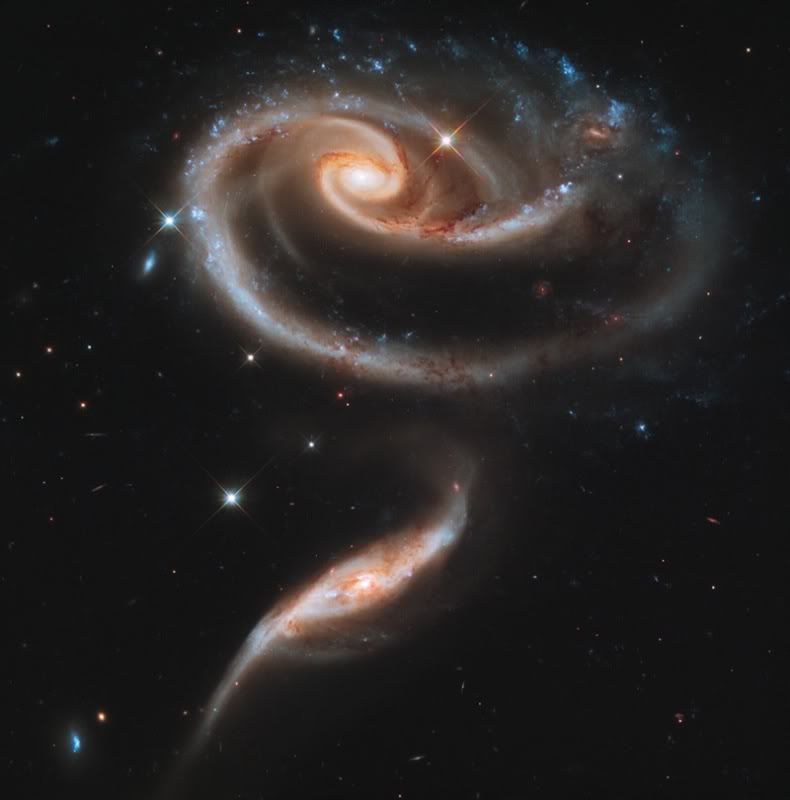It is Earth Day, so why not celebrate with two videos that help to celebrate Earth's place in space.
First off is an animated version of Carl Sagan's Pale Blue Dot. I think you will like it.
Pale Blue Dot - Animation from Ehdubya on Vimeo.
I think from now on, April 22 should be celebrated as Pale Blue Dot Day.
The second one, a stunning time-lapse video called Walu Ngalindi, shows our Milky Way galaxy and two of our satellite galaxies as seen from the dark skies of the Australian Outback. Watch it embedded below or follow the link above to see it in much higher resolution.
WALU NGALINDI from GRANT WAKEFIELD on Vimeo.
Friday, April 22, 2011
Wednesday, April 20, 2011
Hubble's 21st Anniversary Pic
It is hard to believe that the Hubble Space Telescope has now been in space for 21 years. This Earth-orbiting observatory began its career looking like it would become a total failure. Thankfully for all of us, the technical team diagnosed the problem and astronauts were able to successfully install optics to correct for the telescope's flawed primary mirror.
The repairs, and later upgrades, to the telescope have made it such a smashing success that most people have totally forgotten that HST nearly became the most expensive failure that astronomy had ever known. (It is still by far the most expensive telescope ever built.)
Instead, we celebrate its achievements and the HST team has given us this image to mark its 21st anniversary in space:
From the HST press release:
The repairs, and later upgrades, to the telescope have made it such a smashing success that most people have totally forgotten that HST nearly became the most expensive failure that astronomy had ever known. (It is still by far the most expensive telescope ever built.)
Instead, we celebrate its achievements and the HST team has given us this image to mark its 21st anniversary in space:
From the HST press release:
The newly released Hubble image shows a large spiral galaxy, known as UGC 1810, with a disk that is distorted into a rose-like shape by the gravitational tidal pull of the companion galaxy below it, known as UGC 1813. A swath of blue jewel-like points across the top is the combined light from clusters of intensely bright and hot young blue stars. These massive stars glow fiercely in ultraviolet light.
The smaller, nearly edge-on companion shows distinct signs of intense star formation at its nucleus, perhaps triggered by the encounter with the companion galaxy.
Arp 273 lies in the constellation Andromeda and is roughly 300 million light-years away from Earth. The image shows a tenuous tidal bridge of material between the two galaxies that are separated from each other by tens of thousands of light-years.
A series of uncommon spiral patterns in the large galaxy is a tell-tale sign of interaction. The large, outer arm appears partially as a ring, a feature seen when interacting galaxies actually pass through one another. This suggests that the smaller companion actually dived deep, but off-center, through UGC 1810. The inner set of spiral arms is highly warped out of the plane, with one of the arms going behind the bulge and coming back out the other side. How these two spiral patterns connect is still not precisely known.
A possible mini-spiral may be visible in the spiral arms of UGC 1810 to the upper right. It is noticeable how the outermost spiral arm changes character as it passes this third galaxy, from smooth with lots of old stars (reddish in color) on one side to clumpy and extremely blue on the other. The fairly regular spacing of the blue star-forming knots fits with what is seen in the spiral arms of other galaxies and is predictable based on instabilities in the gas contained within the arm.
The larger galaxy in the UGC 1810 - UGC 1813 pair has a mass that is about five times that of the smaller galaxy. In unequal pairs such as this, the relatively rapid passage of a companion galaxy produces the lopsided or asymmetric structure in the main spiral. Also in such encounters, the starburst activity typically begins in the minor galaxies earlier than in the major galaxies. These effects could be because the smaller galaxies have consumed less of the gas present in their nuclei, from which new stars are born.
Subscribe to:
Posts (Atom)
